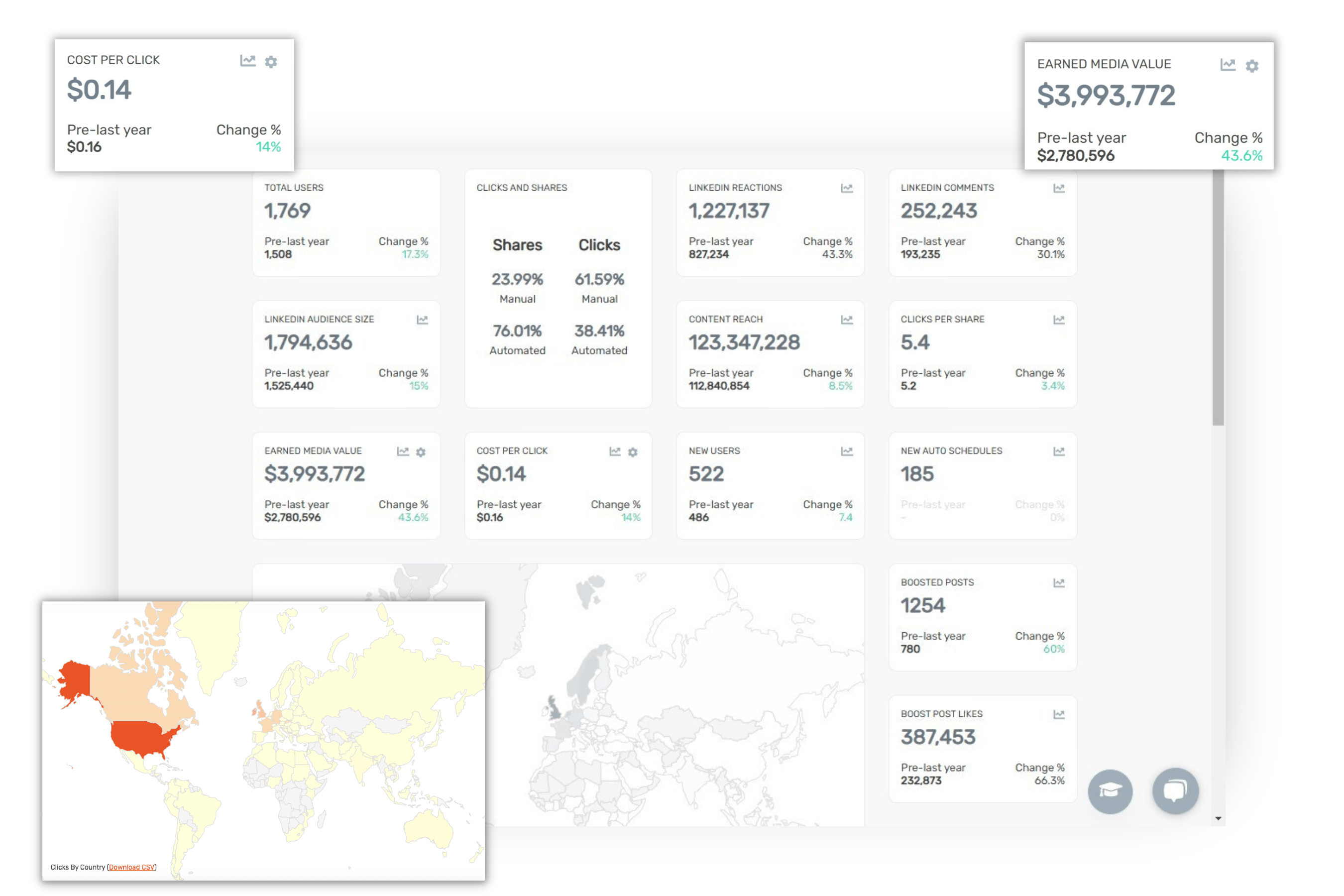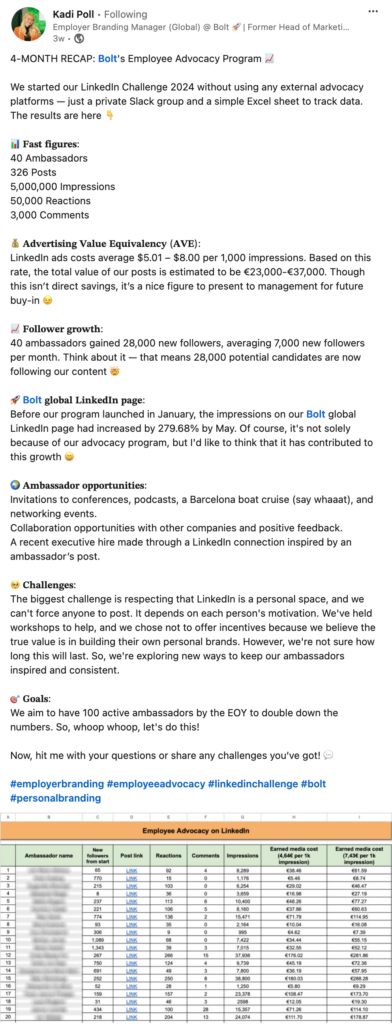
Option 1: Manual Employee Advocacy
First, let’s clarify what a ‘manual’ employee advocacy program means.
We define this as a program management method that uses your existing tools to encourage employees to share content on social media.
In short, there’s no ‘home’ for your employee advocacy program.
Your approach will vary depending on the software your company already uses, but an example setup could be:
Pros and Cons of Manual Employee Advocacy
| Pros | Cons |
| It’s cost-effective to use your existing tools. | Harder to demonstrate ROI without analytics. |
| Easier to get buy-in from leadership as no additional investment would be required. | More time and effort required from advocates & admins for curating and sharing content. |
| A good way to test a pilot program before investing in software. | No gamification to motivate participation. |
| Can be cumbersome to switch between multiple tools for marketing, social media and communications. | |
| No app for employees not office-based to share content. |
If you’re in a small organization with, let’s say, 20 advocates, this approach could work.
However, issues arise when scaling your program.
You’ll need a way to segment your content to get it to the right people, for example by seniority, department, or region.
But that’s not to say it’s not worth testing employee advocacy this way!
It can be a great method for gauging employees interest, while supporting your organic social media strategy on a smaller scale.
Below is a great example from Bolt, a software company. Employer Branding Manager Kadi launched an employee advocacy program using their existing tools: Slack for communications and Excel for tracking data.
After just 4 months, they’ve reached a whopping 5 million impressions with 40 employee advocates.
Trialling employee advocacy manually with a select group, e.g., your sales and marketing team, can also help you gain buy-in for an official program.
If you’re already at this stage, Bradley and Lewis cover the transition to a formal program in this episode of the Employee Advocacy and Influence podcast:
Option 2: Social Media Management Tools with Employee Advocacy Add-Ons
The second option for managing your advocacy program is to use a social media management tool that offers employee advocacy upgrades or add-ons.
The key thing to keep in mind when considering this approach is the end user – your employee advocates.
Ask yourself these questions:
- Is the platform user-friendly for someone who isn’t a social media marketer?
- Am I looking to onboard employees who aren’t office-based? If so, does the solution come with a mobile app for end users (not just admins)?
- Do the features included support employee advocacy success? For example, gamification for employee engagement, the ability to curate multiple post captions, auto-scheduling, and segmenting users?
Pros and Cons of Employee Advocacy Add-Ons
| Pros | Cons |
| A familiar tool for your social media manager/marketing team. | Some major social media management tools only offer advocacy to enterprises. |
| Ability to manage employee advocacy and brand social channels in the same platform. | Often lacking advocacy-specific features like gamification, internal comms, and mobile apps. |
| Getting buy-in to upgrade a tool you’re already using may be easier. | No home just for advocacy: a dedicated space for building a community around your program. |
| Designed for social media professionals, may be difficult for users in other departments. | |
| Lack of employee advocacy expertise for support and training. |
Managing an employee advocacy program with your existing social media tool is possible, depending on the features required and the size of your program.
It may also be easier to gain buy-in from leadership to upgrade a tool your marketing team is already using.
However, it’s important to keep in mind that these platforms are designed for marketers.
They may not be user-friendly for employees who aren’t experienced with social media, and often miss key features for internal communications and user adoption.
In addition, the support and training offered by social media solutions such as Hootsuite and Sprout Social will naturally be less tailored for employee advocacy compared to a dedicated solution.
Option 3: A Dedicated Employee Advocacy Platform
The final option for managing an employee advocacy program is a dedicated platform.
The most effective way to scale employee advocacy throughout your organization and make it part of your company culture is to create a space for your program to live.
Switching between various tools and social media networks to share company content is time-consuming. Many employees won’t do it.
With a platform like DSMN8, advocates can log in on their desktops or use the mobile app to find relevant content to share easily. It can even be automated.

Internal communication features enable you to build a community around your program, from gathering feedback and content suggestions to sending virtual ‘high fives’. Motivate your team with gamification: competitive leaderboards with the option to offer real rewards.
Employee advocacy with DSMN8 is more straightforward for program managers and admins, too.
With ‘Dynamic Display’, content curators can share multiple post captions, images, and link preview titles for every piece of content.
No more identical posts in your LinkedIn feed! 👏
Segment users by groups and teams to get the right content to the right people, tag posts as ‘evergreen’ or ‘strategic’, and ‘boost’ content by your CEO or board members.

To analyze performance, admins can dive into the analytics suite for individual users, groups/teams, and the whole program.
Find out which content is driving results to adjust your content strategy and demonstrate ROI with earned media value.
How DSMN8 works, in 90 seconds:
Of course, platform features and functionalities are only one side of the process. The other is support and training.
Our customer success managers are experts, having supported and scaled hundreds of employee advocacy programs.
They’re here to provide guidance and best practices, host training sessions with your team, and conduct quarterly business reviews with you.
Don’t just take my word for it, check out their reviews on G2!
Additional Resources
For more on how to manage your employee advocacy program and find the right tools for your organization, you’ll find these helpful:
Ready to get started with the #1 employee advocacy platform?
Wondering how active your team already is, and how this compares with your competitors?
Emily Neal
SEO and Content Specialist at DSMN8. Emily has 10 years experience blogging, and is a pro at Pinterest Marketing, reaching 1 million monthly views. She’s all about empowering employees to grow their personal brands and become influencers.




